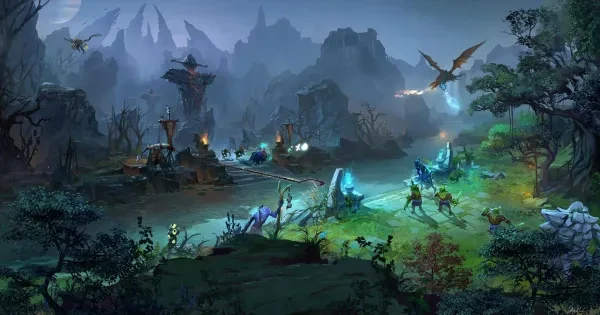The Best Ways to Play Vintage Games on Your Modern TV
[ad_1]
So, you want to play retro video games? Excellent. Whether you’re exploring old favorites or digging for new treasures, there’s a huge library of titles out there waiting for you. Some retro enthusiasts (like your dear author) will fall down the rabbit hole of era-appropriate hardware— original consoles, game paks, and CRTs—but not everyone wants to deal with those hassles (or costs). Fortunately, playing retro games on your flatscreen can be just as beautiful and satisfying as lugging a 120-pound CRT up three flights of stairs to your apartment.
I’m going to break down your options—whether you’re using an old 720p LCD or a 4K HDR OLED—to ensure you can get started gaming, no matter your setup or budget. There are all sorts of options, so I’ll start with the most affordable (emulation) and move toward the more expensive “enthusiast” options. Whichever you choose, the only thing that matters is that you have fun.
Press start: How to retro game via software emulation
When it comes to playing old games on modern hardware, you have a few options.
Official subscription services
The easiest option for most people is playing old games on consoles already in your daily rotation. Sony, Nintendo, and Microsoft offer emulation-based backwards compatibility options for legacy consoles like the NES and PlayStation 3 through their subscription-based services: Nintendo Switch Online, PlayStation Plus, and Xbox Game Pass. These services come in at varying price points, but work instantly, provide adequate results, and give you access to a ton of games across various generations and platforms.
Pros: Easy, lots of games
Cons: Separate subscriptions required for each console maker, questionable emulation depending on the game/console
Mini consoles
Over the past several years, Nintendo, Sega, and Sony have also released “mini consoles” which sold like hotcakes, but have started to fade in popularity. Loaded with 20 or so games, these plug-and-play consoles are limited in scope unless you’re willing to install homebrew software (but I’ll let you figure that one out on your own), but offer an effortless way to dabble in old games. Most recently, Sega announced the Mega Drive Mini 2 for Japan, including cult classic Sega CD games like Popful Mail and Shining in the Darkness. They’re usually affordable at release, but can be expensive to acquire on the secondhand market once out of production.
Pros: Easy setup, nostalgic hardware, supports custom firmware and fan hacks
Cons: Difficult to find and expensive on the secondhand market, limited game libraries
Open source emulators
Though emulation has the lowest barrier to entry, it also has potentially the highest ceiling for performance thanks to the brilliant fan community tirelessly improving emulators and old games to take advantage of modern technology and game design theory.
One on hand, there are ROM hacks that offer everything from fan translations of missing Super NES classics to quality of life improvements for legendary games and colorizations of original Game Boy games. These hacks are perfectly legal to download, assuming you have a legally acquired ROM to apply them to, and open up the world of retro gaming in so many ways.
On the other hand, you’ve got engineers using emulators to improve the graphics and sound in older games with things like widescreen versions of Super NES games, an orchestral soundtracks for Link’s Awakening, and the potential to run older games at higher frame rates and resolutions. Particularly impressive is this recent emulator plugin that adds ray tracing to Nintendo 64 games, completely lapping anything Nintendo itself has accomplished via their Nintendo Switch Online + Expansion Pak service:
These fan projects can be played by either downloading emulators on their own, or accessing them via frontend tools like EmulationStation, LaunchBox, and Retroarch on your computer, phone, hacked game console, or, well, almost anything you own with an operating system. Some popular single console emulators include:
Emulation has introduced players to retro games and hard-to-find titles for years, and is at the center of a vibrant and exciting community of retro gamers and preservationists alike. Though legally acquiring the ROM files needed to play games can be challenging, devices like Save The Hero’s Open Source Cartridge Reader make it easy to create ROMs from your game cartridge collection.
Pros: Powerful, covers nearly every game and console ever released, highly customizable and extendable, huge open source community constantly updating software
Cons: Legally acquiring games is challenging, requires high end computer for cutting edge improvements like raytracing
Raspberry Pi
If you want to use emulators on your living room TV, the easiest option is acquiring a small, affordable device called Raspberry Pi. Running an OS like Linux or Android, Raspberry Pi can do a lot of things, but one of its best uses is as a plug-and-play emulation box. Download your favorite emulator, load it up with games, plug it into your TV, and away you go. Since it’s basically a small computer, Raspberry Pi supports many controllers—including Xbox and PlayStation controllers, or the retro-inspired models sold by 8bitdo. A Raspberry Pi is affordable, but doesn’t have nearly as much juice as a PC, so it can’t access a lot of the high end features afforded by PC emulators. But it’s a flexible and convenient starter device for people who just want to play games on their TV—and can be easily popped in your bag to bring on vacation or to a friend’s house.
Pros: Cheap, easy to set up, portable
Cons: Lacks the high end features of PC emulators, can’t emulate more modern game consoles
Level up: How to retro game with hardware emulation via FPGA
The hottest thing in retro gaming over the past few years has been FPGA hardware emulation. It might sound like a golf tour, but holds the potential to change how we think about playing retro games.
FPGA stands for “field-programmable gate array,” and gives developers access to a chip that can be programmed to mimic the architecture of old game consoles. Instead of emulating software—like traditional game emulators—it emulates the hardware itself. When done properly, the game can’t tell the difference between the FPGA chip and original hardware. This results in the most accurate experience of playing old games on modern hardware possible, whether you’re using ROMs or original cartridges.
Analogue
Utilizing FPGA cores developed by an electrical engineer named Kevin “Kevtris” Horton, Analogue’s game consoles play real cartridges and focus on one beloved game console at a time. Though they carry a premium price point, and supply issues can make it hard to get one in your hands, Analogue’s consoles—including the NT Mini, Super NT, Duo, Mega SG—are a perfect melding of retro games and modern hardware.
In this recent Lifehacker piece, Brendan Hesse summed up the appeal of these FPGA consoles, the quickest, easiest way to play old cartridges on your modern TV and have them look great. “While it’s not as ‘pure’ as playing on the old consoles in your collection,” Hesse wrote, “cloned consoles will play the game cartridges you already own, automatically upscaling the video signal so it looks good on your newer TV—no converters or special cables needed.”
Analogue’s most recent release is the handheld Pocket, which supports all sorts of handheld consoles, including Game Boy line, Game Gear, and Atari’s Lynx. Plus, with the official dock, you can even play your game paks on your 4K. Though getting one without paying outrageous secondary market prices requires waiting until 2023 thanks to overwhelming demand and worldwide supply issues.
Pros: Gorgeous retro games right out of the box, high quality materials, major nostalgic appeal, lots of customization options/filters
Cons: Expensive and difficult to acquire, single console focus, officially requires real game cartridges
MiSTer
Analogue’s devices are (officially) limited to specific consoles—but what if I told you there was a single device that could play everything from Commodore 64 to Super NES, TurboGrafx-16, and PlayStation with hardware accurate FPGA emulation? Say hello to the MiSTer.
Whether you order parts individually and construct the MiSTer yourself, or buy a prebuilt one from somewhere like MiSTer Addons, this highly customizable and scalable device runs on the impressive DE10-Nano chipset with a Cyclone V FPGA and supports an absurdly deep library of games and consoles. YouTubers My Life in Gaming have produced an extensive (like, we’re talking two-and-a-half-hour) look at the MiSTer in 2022—including a how-to on assembling and setting up your device, recommended add-ons, and looks at the most popular console cores—that will tell you most of what you need to know.
Of everything I’ve covered, MiSTer has the highest crossover potential for satisfying enthusiasts and casual fans alike—its combination of scalability, flexibility, and breadth offers something for everybody. MiSTer boasts a vibrant FPGA development community that’s only just beginning to tap into the technology’s potential, and we’re only going to see more consoles, more compatibility, and more customization as they expand on an already impressive feature set. You can plug one into your modern screen or your CRT, output almost any standard resolution/video signal you’d like, and access a ton of different features like scanline filters, black frame insertion for improved motion blur, robust controller support, and more.
Pros: Endlessly customizable, highly scalable, huge library of hardware and software support, regularly updated with new features
Cons: Expensive and complicated to set up, support for post-16 bit consoles still under development
Now you’re playing with power: Original hardware + scalers
“But, Aidan, I’ve got a collection of retro consoles and games that rivals MetalJesusRocks, but CRTs are lame. I wanna play on my 70″ 4K without the games looking like garbage.” Well, you’ve got options…as long as you’re willing to pony up for them.
The NTSC broadcast standard used in many non-European regions output 480i resolution (240 alternating lines spread top-to-bottom on the TV screen), but video games cleverly cut this in half to more efficiently use console processing power—resulting in a video standard called 240p. Trouble is, most modern TVs don’t care about 240p video because it hasn’t been used much since the ‘90s. This results in poor upscaling of retro game consoles, muddy looking games, and terrible controller lag.
Enter: upscalers. These devices take your game console’s 240p (or 480i, for later consoles) signal and upscale it as cleanly as possible for display on an HD or 4K screen while introducing minimal input lag. They’re kinda magic, honestly. The major downside to scalers is that even the older ones are expensive, and newer ones have been heavily impacted by supply chain issues and increasing component prices. So consider these a higher tier option for those serious about committing long term to original hardware and software—not an entry point.
Mike Chi’s RetroTINK-5X Pro is the leading FPGA-powered upscaler on the market right now—truly impressive, since Chi’s a one-man operation. The 5x in the name refers to the upscaler’s ability to enlarge the video signal by five times (1200p) without quality loss, producing razor sharp pixels and a variety of scanline and retro filters. Similar devices like the OSSC, Framemeister, and RetroTINK-2X Pro offer similar functionality with fewer features at slightly more palatable price points. Chi is hard at work on a RetroTINK 4K, and other upcoming upscalers like the PixelFX Morph and OSSC Pro look to push the technology even further.
(For a more in-depth look at upscalers and FPGA consoles, refer to Brendan Hesse’s previously mentioned breakdown, which covers more options and optimal settings.)
Pros: So many options, broad console support, original hardware experience, gorgeous video quality
Cons: Expensive, requires access to original consoles and games
Scanlines or razor-sharp pixels?
There’s an argument to be made that the best way to play retro games is on CRTs thanks to their unique look and feel. Others want the cleanest image possible—pixels cut right at the source with no distortion. These FPGA and scaling devices often come with a bunch of features that let you emulate the look of older TVs by including scanline and scaling options to soften up the image, with results pretty close to original CRTs. Twitter accounts like @PROPixels and @CRTPixels do regular comparisons between sharp pixels, retro filters, and original CRTs, highlighting various options to get your games looking as good as possible.
Whether you’re into filters or not is a matter of taste, and might even depend on the console or game, but having the option to produce various types of images is one of the most appealing reasons to use a MiSTer or upscaler compared to options like emulation on modern game consoles—especially when you’ve optimized the settings using a tool like 240p Test Suite.
Next level
However you choose to play your old games—on a flatscreen or CRT, with scanlines or raw pixels—there’s no wrong answer. Experiment to find what looks best to you.
I started out with one of Nintendo’s mini consoles and have upgraded to serious original hardware over time, but that doesn’t mean I don’t still have fun playing emulated games on my phone. My biggest piece of advice is to start small—grab a used mini console, check out ROM hacks of your favorite games, sign up for one of Sony, Nintendo, or Microsoft’s subscription service—and see if retro gaming is right for you. Whether you dabble or dive into the deep end, there’s never been a better time to get into old games, and it’s only going to get better from here.
[ad_2]
Source link








